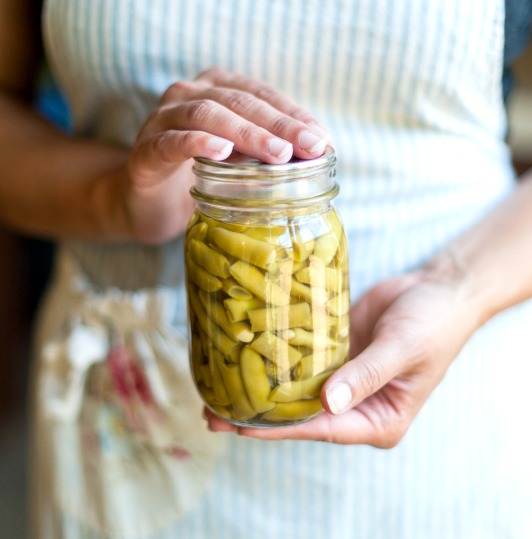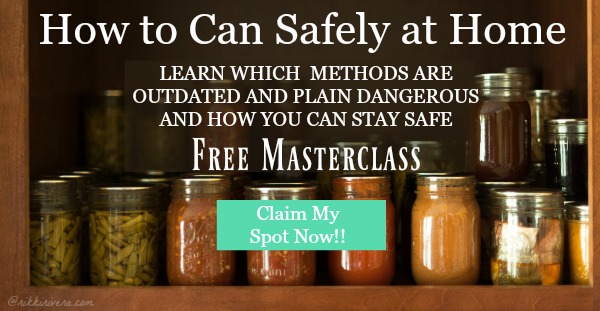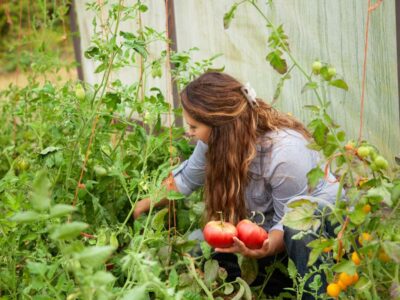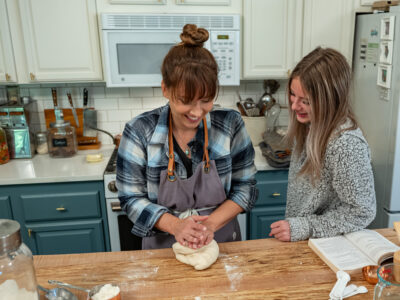How do you know if a canning recipe is safe? Or what do you do when someone isn’t following canning safety? Is there a way to tell if a jar of home canned food someone has given you is safe?
These are legit questions and concerns. I’m thrilled there are so many people getting back to growing and preserving their own food, but with that, there’s a lot of outdated and plain dangerous canning procedures and recipes floating abound.
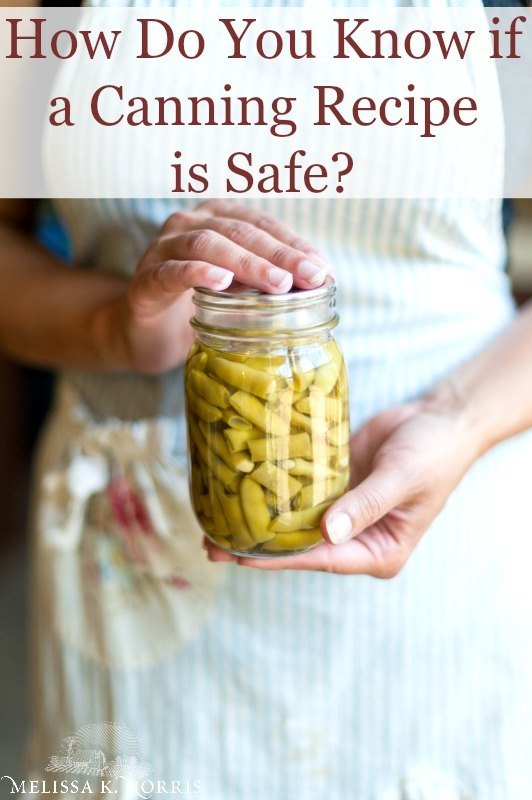
Listen below to, How Do You Know if a Canning Recipe is Safe? #153 of the Pioneering Today Podcast, where we teach families how to grow, preserve and cook their own food using old-fashioned skill sets and wisdom to create a natural self-sufficient home, with, or without, the homestead. Or click here for Canning 101 Episode #6.
Get every episode as soon as it releases without having to check in to the website or your email by subscribing via your favorite podcast app, Listen on Apple I-tunes , Get it on Google Play Subscribe on Stitcher
Safe canning is pretty straight forward.
Water Bath Canning Safety 101
Water bath canning is when you are processing the contents of a mason jar in a pot of boiling water for a specified amount of time. In order for something to be safely water bathed canned, it must be 4.6 ph or lower on the pH scale because botulism does not grow in an acidic environment. (Learn more about botulism prevention and preservation safety tips and what causes canning lids to buckle or not seal.)
This includes most fruits (but not all, bananas and tomatoes to name a few), pickled vegetables, and tomatoes with added acid. Tomatoes don’t always measuring at 4.6 or lower on the pH scale, which is why we always added acid when we are canning tomato sauce and tomato products.
If you’re following an updated pickling recipe that that brine ratio has been tested so that we know that the overall contents of the jar is 4.6 or lower, we’re good to go.
Pressure Canning Safety 101
All vegetables that are not pickled, all meat, and soups, have to be pressure canned because it’s a non-acidic environment. Botulism spores can grow and the only way to kill those spores without the acidity level being 4.6 or lower is to heat the contents of those jars up to the temperature when your pressure canning, which for your non-acidic vegetables and meats is going to be 248 degrees Fahrenheit or higher, which is your 10 pounds of pressure.
If you live 1001 feet above sea level, so you are higher altitude, then you’re going to be using 15 pounds of pressure for your vegetables and your meats and your soups and those combination of things.
How do you know if a jar of home canned food is safe
You cannot tell by looking at a jar of home canned food if it is safe, just because it’s sealed, does not mean that it’s safe. A seal just means that you had vacuum action from it getting hot and cooling down. A sealed jar is in no way an indication that the food is safe or not.
If someone that you don’t really know their canning practices or their kitchen, but someone hands you a jar of home canned food, you might be wondering like, “Oh, goodness. How do I know if this was canned properly,” right? That’s a legitimate thing. I don’t think we should feel bad for wondering that. The safety of our family is something that’s really a high priority.
And this has happened to me. I’ve had people bring me home canned food, and I’m kind of like, “Oh, man. I don’t know how they’ve done this. If it’s been followed with safe procedures or not.”
Simply ask. “How did you can this?” And not like you’re interrogating someone or in a snotty way or condescending. But just simply ask, “Oh, what’s your recipe or how did you go about doing this? How did you can this?” They’ll tell you.
Warning signs it wasn’t canned properly
Not pressure canning vegetables and meat. If it’s vegetables or meat in a jar and they start explaining to you that they water bathed canned it for three hours, then you know that that is not safe because that has to be pressure canned.
Not processing via water bath. They may start sharing if it’s a jam or a jelly recipe (if it contains low acid fruits like bananas or pumpkin this is a big indicator it’s not safe), they may share with you, “Oh, we just boil the contents and you put it in a jar, and then I just tighten down the lid and the seal, and it just sealed,” but they didn’t process it in a water bath. Then you know that is not safe.
Unsafe canning methods are jar flipping, oven canning or open kettle canning. That’s when people have taken usually with jam or jelly, sometimes with pickled foods. So they’ve taken the hot contents, right? Poured it into that mason jar. They’ve put the lid on, screwed the band down, and sometimes they’ll flip the jar upside down and then later flip it upright and it will seal because it’s simply sealing because hot and then cooling has created a vacuum action.
The whole point of processing it in the water bath is to kill any bad bacteria, and it doesn’t matter if you have sterilized the jar and then you’re pouring that boiling liquid in because bacteria is always present and will enter the jar faster than you can pour. Botulism spores are actually everywhere too. We come in contact with botulism all the time. It’s when it’s in a sealed jar that doesn’t have oxygen in it, which is a sealed canning jar, that it multiplies and becomes an issue.
When we are canning acidic foods we process them in the water bath is to kill any bacteria because with bacteria, it doesn’t matter how fast we’re pouring into a sterilized jar and slapping that lid on and screwing that band, bacteria can get in there. Our hands are washed and of course we’re practicing good sanitary things in our kitchen. That’s just the nature of it. That’s why a lot of times in the old days they would open up a jar of jam or jelly and there would be mold present.
Mold on Jam and Jelly
And if you see mold, just scrapping it off, mold grows downwards and it grows by spores. So if it’s to the point where you can see it, just because you scrap off that top inch of that top layer of mold, those spores have already traveled down in throughout the contents of the jar. You just don’t necessarily see them.
I hear people say a lot, “Well, my grandparents did that and we would just always scrape the mold off and we were fine.”
Well, a lot of times, people would get sick with things and they didn’t even know back then that it was related to their food. Sometimes people are fine, but other times if you’ve got upper respiratory issues, weakened immune systems, I mean, there’s a whole bunch of things. It can cause serious complications and people didn’t realize back then that it was likely from their food.
Why are you taking a short cut at the end
My whole other thing is we’ve got the benefit of tested recipes and tested procedures. We’ve got the benefit of all of that. Why wouldn’t we do it?
We go through the work of growing this wonderful, organic, good for you food, making it yourself so that you know it doesn’t have high fructose corn syrup in it. You are controlling the sugar level. There is no food dye. Why wouldn’t you spend that 10 minutes to water bath it to make sure that it’s totally safe and that it’s shelf stable without the mold? Why wouldn’t you do that?
How to know if an old pickling recipe is safe for canning
When it comes to pickled foods, that’s not always as easy to know, and I’m going to say tomato products, salsas, and pickled foods because a lot of time people will take their favorite salsa recipe and other times it’s a favorite pickle recipe that’s been handed down.
Maybe it was great-grandma’s recipe or it was grandma’s recipe, and a lot of those older canning recipes didn’t have the benefit of the testing, and a lot of them aren’t acidic enough.
I look at the recipe, if it’s in the family and it’s grandma’s recipe or great-grandma’s recipe or it’s somebody who’s giving you a jar of it, you can ask them for a copy.
Look up a tested canning recipe source such as the Ball Complete Book of Home Canning or an extension office website. If using a canning book, make sure it’s a book with a publication date of 2000 or newer (that’s my rule of thumb).
Example: We have a mustard pickle recipe that was handed down on my husband’s side from his grandma or his great-grandma. I think it was his great-grandma. I had the written recipe, and a lot of those older recipes too, and this is one if you see this listed as an ingredient, then you know it’s an outdated recipe, and that is using any type of thickener that is flour, corn starch, corn meal, tapioca, arrowroot, any of those are no longer approved thickeners for canning because they can create thick spots in the jar. Based on safe canning practices and recipes, I updated our family favorite to this safe version of Mustard Pickles.
If you have a spot that is too thick, the heat cannot get through that spot to sufficiently kill the bacteria spores that we needed to kill in order to keep it safe. So if I’m looking at any recipe and it’s got that in there, then I immediately know that that recipe is outdated and I either need to go find an updated source or not use it.
Find a similar recipe from a tested source
Tested Canning Recipe Sources
Canning Tutorials & Courses
Free 4 part video series on learning how to safely pressure can
Home Canning with Confidence, complete course to teach you every step of safe canning from water bath to pressure canning with over 65 recipes
Canning Books
Ball Blue Book of Canning dated 2000 or newer
Ball Complete Book of Canning (this is one of my favorite canning books)
The Farm Girl’s Guide to Preserving the Harvest: How to Can, Freeze, Dehydrate, and Ferment Your Garden’s Goodness
Trusted Safe Canning Recipe Websites
MelissaKNorris.com Canning Recipes
National Center of Home Food Preservation
State Extension Offices
Fresh Preserving (owned by Ball/Kerr)
I went to my Ball Complete Book of Home Preserving book, and there is a recipe in there that has a mustard pickle recipe in it that uses clear gel, which is the only tested and approved thickener to use when you are canning.
That’s what you’re going to be using for pie fillings, if it’s some type of relish recipe that calls or a sauce that calls for a thickener. Clear gel is the only approved canning thickener to use. And I go into a lot more detail on exact science and more on this in the free home canning safety class. I highly recommend that you go and take that class if you haven’t been through it yet for more in depth detail and on a whole lot more than just that.
I went to that recipe from Ball and I made sure that the non-acidic to the acidic ratio was following that updated tested recipe. I took great-grandma’s recipe, looked at an updated recipe, and made sure that the acidity ratios all stayed the same as that tested recipe in order to keep us safe and that pH level of 4.6 or lower.
The only way to keep it safe is to follow a tested recipe for the acidity and ratio of non-acidic ingredients to acidic ingredients.
You can never alter the acidic to non-acidic ratio. If it calls for two cups of vinegar and one cup of water and two cups of onion, you can’t increase it to three cups of onions because then you’re increasing non-acidity.
If the brine calls for two cups of vinegar and one cup of water, you can’t say, “Oh, that’s too vinegary for me. I want it to be two cups of water to two cups vinegar,” because you’re decreasing the acidity. So you can’t do that.
Now you could look at it and be like, “Well, I don’t really like that much onion flavor. I don’t like that much pepper.” If it called for two cups of onions, and you could decrease it to one cup of onions because you’re just omitting some of the non-acidic but you’re actually creating a more acidic recipe as long as then you don’t try to add something else back in.
If it’s something that’s really spicy and you’re like, “Oh, I don’t like that many peppers,” you can take a pepper out, but you can’t increase it and make it more spicy because then you’re altering that careful balance where it’s been measured with acidic to non-acidic ingredients.
I’ll find that updated tested recipe and make sure those ratios are following the tested recipe, and if not, then I don’t use that old one.
What to do when the recipe is not updated or safe and the person doesn’t want to change it
You’ll often hear, “Well, I’ve been doing like this for generations and nobodies gotten sick.”
This can be hard because we love our family and our friends, right? I mean, if we’re eating somebodies food, usually that means you’re pretty close to them and you’ve got a relationship with them and we don’t want to alienate anybody and we don’t want to hurt their feelings.
But when you know something is not safe, we also want to approach that, and our hope is then they will do it the safe way, right? So this can be really hard. And you’re going to have to know what your relationship is with the person and how you can talk to them and how open they are to things.
You can share something like this, “I just learned a lot about canning and science and making sure that we’re updated, and this is the reason why we do this now. For example, people used to water bath canned vegetables and not pressure can them a long time ago, but we know that botulism is not killed on non-acidic foods. No matter how long you water bath it, the temperature of boiling water is always 212 degrees Fahrenheit, y’all. It doesn’t matter if you boil that water for five hours. It doesn’t ever get any hotter than that. So we know that that’s why we pressure can non-acidic vegetables because we’ve got to get that temperature up to that 250 degree Fahrenheit mark in order to kill the botulism spores.”
Some people just don’t know and then when they find out, they’re like, “Oh.” Then they’re excited to learn and to do things the safe way.
But that does not always happen unfortunately.
Despite sharing the reason for canning safety you might hear back, “We’ve done it this way for 50 plus years and nobodies gotten sick yet.”
That’s a tough spot to be in because a lot of people know that we know that smoking cigarettes is carcinogenic and can cause cancer. Some people still choose to smoke, and they haven’t gotten cancer yet. Some of you may be like, “Really? You’re comparing unsafe canning or outdated canning practices to smoking?” Yeah, I kind of am.
Just because you haven’t got sick from something yet doesn’t mean that you won’t, and especially when it comes to those non-acidic foods or pickling recipes not being acidic enough and we’re talking about botulism. I love canning, y’all, and I’m not trying to do any type of scare mongering at all. Botulism is a neurotoxin. It can be a fatal form of food poisoning.
Is it fairly rare? Yes, it is, thanks to the good Lord above, we don’t have a ton of botulism cases. But we know how to avoid it and how to stay safe with canning. That’s the whole point of the updated and the tested recipes and procedures is so that you don’t have to worry about it and so that you’re avoiding it.
If I’ve had a discussion on canning safety and that person doesn’t want to change their ways or their practices, then I have made the decision to not eat the food that I know has not been preserved in a safe manner.
You don’t have to make a big deal about it. When those items are served that I know haven’t been safely canned, then we don’t put it on our plate or eat them. Of course, everybody will be making their own decision on how they’re going to do that. That is how I’ve decided to handle it, I’d rather be safe than sorry.
If you have ran across that and you’ve got some ideas or suggestions for handling those situations because sometimes with homesteading we just run into those situations that are just kind of difficult, right? I would love to hear about it.
More Articles on Home Food Preservation
- 10 Ways to Preserve Food at Home
- Proper Canning Headspace (Is it Important?)
- How to Preserve Zucchini
- Tips for Home Food Preservation – Seasonal Preserving Each Month
- A Complete Guide to Home Food Preservation (What to do When You Can’t Find Canning Supplies)
- Home Food Preservation- Preserving Plan for a Year’s Worth of Food
- 9 Ways to Preserve Food at Home
- How to Store Home Canned Food Safely – Jar Stacking & Canning Rings
- 129+ Best Canning Recipes to Put Up This Year
- How to Preserve Meat, Eggs, & Dairy
- How to Pick the Best Preserving Methods
- How to Convert Recipes for Canning + Safety Tips
- The Science of Home Food Preservation
